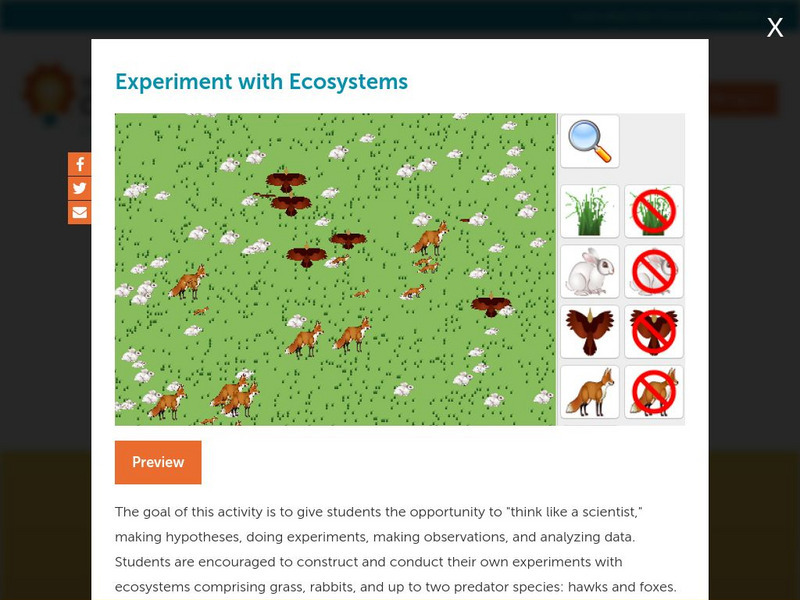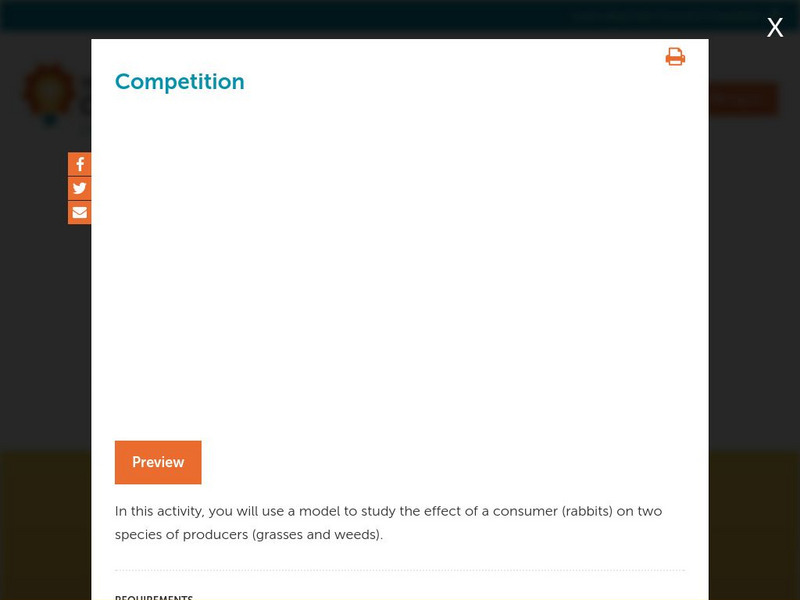Other
Food Chains and Webs
A very informative site that discusses food chains and webs in detail. Not too complicated and fairly easy to understand, it also includes some pictures.
Concord Consortium
Concord Consortium: Stem Resources: Experiment With Ecosystems
Learn what happens to different populations of organisms as their ecosystem changes. Design your own experiment and make your own guesses with what the result will be with this virtual ecosystem. Also experiment with producer/consumer...
Annenberg Foundation
Annenberg Learner: The Habitable Planet: Ecosystems: Energy Flow Through
Detailed explanation of the processes by which energy flows through an ecosystem. Scroll down and open Section 3.
Utah Education Network
Uen: Nhmu: Living Food Web
Fourth graders will be able to name some plants and animals that live in Utah's desert, forest or wetland ecosystems.
Other
The Habitable Planet Simulation
This activity is designed to accompany an interactive on the Annenberg Learner website. Students investigate the changes that take place in an ecosystem when they alter the organisms in a food web. As they work with the simulation, they...
Council for Economic Education
Econ Ed Link: Lean on Me! We Depend on Each Other!
Click and drag each picture to put the steps of producing and consuming a book in the correct order.
Utah Education Network
Uen: Biological Energy Food Chain Practice
After reviewing the roles of consumers, producers and decomposers, you'll create your own food chains using pictures from magazines. The site also has 18 questions to see if you can identify the ecologic role played by various organisms.
CK-12 Foundation
Ck 12: Biology: Food Chains and Food Webs
[Free Registration/Login may be required to access all resource tools.] Describes how food chains and webs represent feeding relationships.
Science Struck
Science Struck: Learn All About the Ocean Food Chain
Read about the different predators, consumers, and producers that make up an ocean food chain.
Science Struck
Science Struck: Rainforest Food Web
Explains the characteristics of tropical and temperate rainforests and what rainforest food webs look like.
Texas Education Agency
Texas Gateway: Organism Relationships: Food Chains, Webs, Pyramids
Given illustrations, students will analyze the flow of matter and energy in food chains, food webs, and ecological pyramids.
Concord Consortium
Concord Consortium: Stem Resources: Competition
An interactive activity where students study how two species of producers are affected by a consumer. By completing several virtual experiments and collecting data, students will be able to summarize what plants can do to defend...
Council for Economic Education
Econ Ed Link: Hey, Mom! What's for Breakfast?
In this lesson students working in cooperative groups will: 1.Discuss food items they consume for breakfast. 2.Investigate elements of foreign culture, particularly food. 3.Use map skills to locate selected foreign nations. 4.Increase...
Council for Economic Education
Econ Ed Link: Incentives Influence Us
Find out more about the concept of incentives in our economy through this lesson plan. "You will identify incentives used at home and school."
University of Nebraska Omaha
Ecedweb: Explorations in Economic Supply, Part I
Examines how supply relates to economic decision making. Using the example of purchasing blue jeans, students take the role of producer to determine how many blue jeans they would supply to the market. Includes links and discussion...
University of Nebraska Omaha
Ecedweb: Explorations in Supply, Part Ii
In this economics tutorial, you as a producer have to determine how much of a given product you should make.
Planet Pals
Planet Pals: The Food Chain
Omnivores, herbivores and carnivores are waiting for you. The food chain comes to life at this friendly site.
University of Michigan
University of Michigan: The Concept of the Ecosystem
Lesson looks at the definition of an ecosystem, biogeochemical cycles, and factors responsible for the differences between ecosystems.
Federal Reserve Bank
Federal Reserve Bank of St. Louis: What Is Driving Oil Prices?
As the world's demand for oil rapidly increases, so do the prices for it. Learn the factors causing high oil prices and who are the world's largest consumers of petroleum. Includes discussion questions. (Published Jan. 2005)
Council for Economic Education
Econ Ed Link: Hey Pop!
One of the best sounds and smells is fresh popcorn! At the movies, at the fair, or at home, everyone likes to munch on popcorn. What is your favorite brand? Is the most expensive the best? You will conduct a taste test to find out. You...
Other
College of Du Page: Energy in an Ecosystem
Ecosystems contain two kinds of commodities: matter (nutrients) and energy. Nutrients cycle through the ecosystem, available for repeated use by organisms. These cycles of use and reuse are called biogeochemical cycles. Energy instead is...
SMART Technologies
Smart: Energy Flow in an Ecosystem
Students learn about Abiotic and Biotic Factors and how they affect the ecosystem in which an animal might live in.
CK-12 Foundation
Ck 12: Fifth Grade Science: Life Science: The Flow of Energy in an Ecosystem
A module that explains what an ecosystem is and how energy and matter move through them. Students will look at the different roles of plants and animals and at ecological relationships in food chains and food webs.
Independence Hall Association
U.s. History: Books and Movies
A look at the literature and movies written and produced in the Jazz Age. See how the writers of the age reflected the consumer society and the emptiness of middle class. Movies appealed to mass culture and millions went to the movies...












